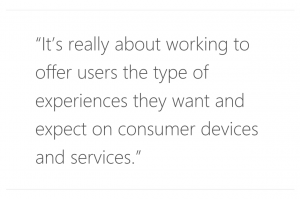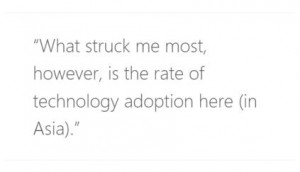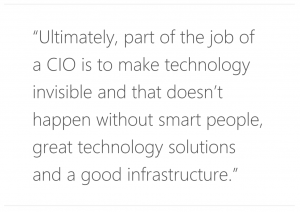
Alan Stone, Senior IT Director for Microsoft Asia, shares his thoughts about the challenges for CIOs today and how they, like Microsoft, can remain relevant in the changing landscape of the IT industry in Asia.
Let’s consider these numbers. There are more than 1.2 million devices connected on our internal Microsoft network, with about 300 to 400 authentications a second on the Active Directory Federation Services (ADFS) infrastructure. In the next year or two, two-thirds of the devices connected are expected to be individually owned.
For a company with 33,000 employees in 77 offices in Asia, Microsoft is probably a good example of how enterprise IT has changed in this region. Consumerization of IT, in particular, has been a hot topic that keeps coming up in conversations with my peers, especially when talking about megatrends in the industry. (In simple terms, Consumerization of IT is commonly referred to as the use of consumer technology products and services in the workplace.)
I can still recall how things were when I first started in Microsoft about 15 years ago. The IT department pretty much dictated everything, from the terms and policies to the equipment issued and what you can do with it.
These days, it’s quite a different ball game. People are bringing in their own devices and using it in the office environment. For most parts, it’s really about understanding the needs of the people who work for Microsoft and translating them into technological needs. It’s really about working to offer users the type of experiences they want and expect on consumer devices and services. In a way, it’s like individualizing the experience.
And as we go forward in the Internet of Things (IOT), I believe that devices such as phones, tablets and PCs, will need to allow for more seamless experiences. Ultimately, moving completely to the public cloud (from hybrid cloud) will allow us to better react and cater to the needs of users. One thing is for sure. Things will be very different in the next three years. And the role of the CIO will have to evolve in order to stay relevant in the industry.
The Asia mantra
Fundamentally, the role of a CIO is the same, whether you are in Europe, America or Asia: To enable the organization to operate at its most efficient and to deploy the right technology that can inspire the industry and encourage customers.
But as I have come to realize over the past seven years working in Asia, this is a huge region with a rich diversity of cultures. What struck me most, however, is the rate of technology adoption here. I am particularly inspired that there is a real thrust from individuals to get consumer-type experience in their workplace right from the start.
In a way, based on my experience, consumerization kind of started in Asia. I remember witnessing first-hand, how people were changing phones like every six months, about going to Japan to see usage patterns and to Korea to experience how people shop online. This got me thinking: If this is the experience that can motivate people to try and use technology, how can I create the same experience in the organization so people are happy to use the solutions we provide rather than treat them as overhead? How can make we make IT invisible while enabling people to do what they need whenever they need to, wherever they want?
Challenges for CIOs today
What I find most interesting when I talk to CIOs these days is that everybody understands what cloud technology is all about. Gone are the days when I need to go to a company and talk to them about what the cloud can offer. What seems to be of greater interest is the change management process and the envisioning process. Many CIOs are keen to know how they can convince the CMO or CFO to invest the resources and time for the company to take that first step to adopting cloud technology. After all, CIOs generally understand that the way we do things today is not the way we have to do them tomorrow.
The next challenge is really about finding the right people with the right skill sets to make the transformation. Some of the questions include: How do I upscale the people I have as I move into processing big data? How do I ensure we are moving the skill set and the people we’ve got effectively from back office to front office roles, critically in field offices?
In Microsoft, we have an initiative called Work Smart, which is really about enabling employees at all levels of the company to leverage technology to its fullest through regular tips and tricks, workshops and openly sharing how users just get work done more efficiently. We consider ourselves as Microsoft’s first and best customer and within that is a process called dogfood. Dogfooding is really about deploying beta technology into the enterprise and making it work and then feeding it back to the engineering groups about how it didn’t, so that it’s battle ready before it goes to market. What this means is that our users are exposed to new technology far more than the average company.
Most conversations about devices tend to veer toward security and how to secure them effectively in an enterprise environment. In Microsoft, we have built a process around devices where the type of device you have and the identity become important together. If you have a device like the Surface Pro 3 which we are confident of protecting, full access to resources and files will be given according to your designation. Partial access and no access may be given if the device used cannot be properly secured.
One thing we have found is that while access can never be 100 percent secure, it has been relatively productive to educate users, for instance, on how to prevent phishing attacks.
How CIOs can stay ahead
CIOs need to do more than just talk to technology leaders to stay ahead in the competitive IT landscape. Personally, I find myself spending more time with Microsoft’s business leaders to better understand where Microsoft is going, their long and short terms goals and how that is going to land in this geography.
I want to be the person who talks to leaders in Asia about this is what you should be doing next, this is where tech is going and this is where the market is going. Smart IT leaders these days are listening to all three contexts and bringing them together and are able to visualize what things will look like. For me, one of the great things about being in a progressive IT organization, like Microsoft, is being able to bring a lot of context together.
To truly be in the leaders’ circle, I find it important to be able to have an opinion you can express in business language. I see many people struggling to express a great idea through technology.
Ultimately, part of the job of a CIO is to make technology invisible and that doesn’t happen without smart people, great technology solutions and a good infrastructure.







